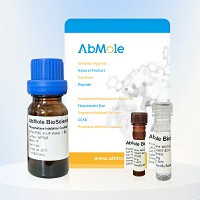
Species: Human
Expression system: Mammalian
Apparent molecular weight: 50-60 kDa, reduction conditions
Endotoxin: less than 0.1 ng/µg (1 EU/µg) by LAL test
Purity: > 95% as determined by reduced SDS-PAGE
Storage and stability: Storage temperature ≤-70℃, stable storage for 6 months after receiving goods. After opening, store in aseptic condition for 3 months, storage temperature ≤-70℃. Please minimize freeze-thaw cycles.
Bioactivity: Beta1,4-Galactosyltransferase-I (B4GALT1), one of seven beta1,4-galactosyltransferases, is an enzyme commonly found in the trans-Golgi complex that adds galactose to oligosaccharides. By sequence similarity, the beta 4GalTs form four groups: beta 4GalT1 and beta 4GalT2, beta 4GalT3 and beta 4GalT4, beta 4GalT5 and beta 4GalT6, and beta 4GalT7. beta 4GalT1 is unique among the seven enzymes because it can be expressed either as membrane associated form or secreted form. The secreted form is restricted to lactating mammary tissues where the enzyme forms a heterodimer with alpha -lactalbumin to catalyze the synthesis of lactose. The Golgi complex form catalyzes the production of lactose in the lactating mammary gland and could also be responsible for the synthesis of complex-type N-linked oligosaccharides in many glycoproteins as well as the carbohydrate moieties of glycolipids. The cell surface form functions as a recognition molecule during a variety of cell to cell and cell to matrix interactions, as those occurring during development and egg fertilization, by binding to specific oligosaccharide ligands on opposing cells or in the extracellular matrix. Defects in beta 4GalT1 are the cause of congenital disorder of glycosylation type 2D (CDG2D) .
| Storage |
Powder -20°C 3 years ; 4°C 2 years In solvent -80°C 6 months ; -20°C 1 month |
| Species | Mouse | Rat | Rabbit | Guinea pig | Hamster | Dog |
| Weight (kg) | 0.02 | 0.15 | 1.8 | 0.4 | 0.08 | 10 |
| Body Surface Area (m2) | 0.007 | 0.025 | 0.15 | 0.05 | 0.02 | 0.5 |
| Km factor | 3 | 6 | 12 | 8 | 5 | 20 |
| Animal A (mg/kg) = Animal B (mg/kg) multiplied by | Animal B Km |
| Animal A Km |
For example, to modify the dose of Compound A used for a mouse (20 mg/kg) to a dose based on the BSA for a rat, multiply 20 mg/kg by the Km factor for a mouse and then divide by the Km factor for a rat. This calculation results in a rat equivalent dose for Compound A of 10 mg/kg.
[2] Daniel Taliun, et al. Nature. Sequencing of 53,831 diverse genomes from the NHLBI TOPMed Program
| Related Recombinant Proteins Products |
|---|
| Recombinant Human EpCAM/Trop-1 (Mammalian, C-Fc)
Epithelial Cell Adhesion Molecule (EpCAM) is a signal type I transmembrane glycoprotein. EpCAM plays a role in embryonic stem cells proliferation and differentiation; it up-regulates the expression of FABP5, MYC and Cyclin A and Cyclin E. It is highly and selectively expressed by undifferentiated embryonic stem cells. |
| Recombinant Human IL-36 gamma/IL-1 F9 Protein (E. coli, aa 18-169, His Tag)
The recombinant human IL1F9 consists of 168 amino acids and predicts a molecular mass of 19.1 KDa. A DNA sequence encoding the mature form of human IL1F9 (Ser18-Asp169) was expressed with a polyhistide tag at the N-terminus. |
| Recombinant Human IL-36 gamma/IL-1 F9 Protein (E. coli)
The recombinant human IL1F9 consisting of 169 amino acids and has a calculated molecular mass of 18.9 kDa. A DNA sequence encoding the human IL-1F9 isoform 1 (Met 1-Asp 169) was expressed. |
| Recombinant Human APOL1 Protein (Baculovirus-Insect, C-His)
APOL1, also known as apolipoprotein L1, belongs to the apolipoprotein L family. It may play a role in lipid exchange and transport throughout the body. |
| Recombinant Human KGF/FGF-7 Protein (E. coli, His Tag)
KGF/Fibroblast growth factor 7 (FGF7) plays an important role in regulating the proliferation, migration, and differentiation of cells. FGF7 is of stromal origin and produces a paracrine effect on epithelial cells. |


Products are for research use only. Not for human use. We do not sell to patients.
© Copyright 2010-2023 AbMole BioScience. All Rights Reserved.
